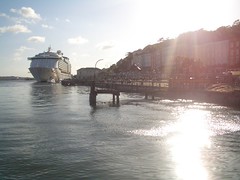 This is a photograph from the Titanic taken by Father Browne on the journey between Cherbourg and Queenstown. It is often used to counter the argument that the Titanic was 'speeding' on her maiden voyage. The wake of the ship can clearly be seen on the ocean surface and indicates that the Titanic was taking a meandering course. While making such manoeuvres it would be impossible to go at full speed. Of course this was part of the commissioning process and was used to test the compass and navigational instruments. However, this was only on the first leg of the journey.
This is a photograph from the Titanic taken by Father Browne on the journey between Cherbourg and Queenstown. It is often used to counter the argument that the Titanic was 'speeding' on her maiden voyage. The wake of the ship can clearly be seen on the ocean surface and indicates that the Titanic was taking a meandering course. While making such manoeuvres it would be impossible to go at full speed. Of course this was part of the commissioning process and was used to test the compass and navigational instruments. However, this was only on the first leg of the journey.At the time the fastest liners on the Atlantic were the Cunard ships Lusitania and Mauretania. In the decade prior to 1912, both ships vied for the Blue Riband, the coveted title as the fastest ship to make the Atlantic crossing. Although, the Titanic was built more for comfort than for speed it would have been tempting to try for that coveted title on her maiden voyage; after all she did have the speed.
The starting point for the Blue Riband was generally accepted as the Daunt Rock, off Queenstown (as Cobh was then known). As Titanic set sail from Queenstown and set course for the finishing line of the Blue Riband, Ambrose Rock off New York, its quite plausible that Captain Smith's instructions were for full speed. Titanic had a capability of at least 24 knots and when she collided with an iceberg, three days later, the ship was travelling at 21 knots. The US inquiry admonished Smith for such speed, particularly, in the light of severe ice warnings that had been issued in the hours leading upto the collision. Many survivors in their testimony expressed shock at the volume of large icebergs they had seen as dawn broke over the collision site prior to their rescue. Many of the icebergs were over 200 ft in height and there was such a proliferation it was hard to imagine how any ship could escape contact without a slow and tricky negotiation of the malaise.
Was Captain Smith, under possible instruction from Bruce Ismay, owner of the White Star Line, attempting to capture that Blue Riband title? If Titanic had crossed that finish line off Ambrose Rock all would have been quite clearer. However, what is clear is that Titanic was travelling too fast at 21 knots to successfully avoid collision with any of the profusion of icebergs that lay in its path off the coast of Newfoundland that Spring!
Explore the many other Titanic stories and the links to Titanic's last port of call at Titanic Packages.

No comments:
Post a Comment